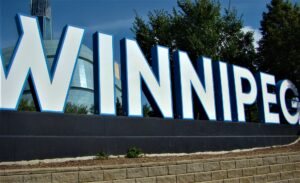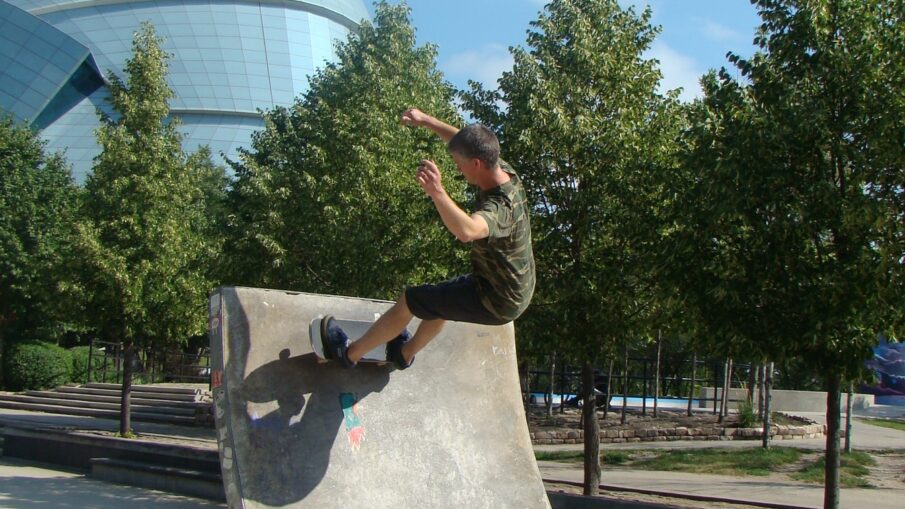Historians say the fork of the Red and Assiniboine rivers long served as a popular meeting place. But The Forks had become a Winnipeg eyesore.
Meetings and business transactions here can be traced back 6,000 years. But by the mid- to late-20th Century, the area was a dingy rail yard on the fringe of Manitoba’s largest business district.
Few would want to go there.
But some ambitious renovation and construction turned this into a site now attracting 4 million visitors each year. That in itself makes The Forks a surprising travel find.
This fascinating effort began about 1990, and now includes a mixed-use environment that includes attractions such as a public orchard, market, riverwalk, and three major museums.
The largest museum is on the outer fringe of The Forks. The Canadian Museum for Human Rights dominates the landscape with a majestic, highly contemporary design. The central tower of the building rises about 250 feet above ground. Queen Elizabeth II unveiled the cornerstone during a 2010 ceremony, and the facility opened to the public in 2014. The mission is to “enhance understanding of human rights through reflection and dialogue.” Adults pay $12 admission; seniors and students pay $10. Check the website for a list of events and exhibits available at the time of your visit. Note that COVID-19 forced cancellation of a number of events that had been scheduled for 2020.
The pandemic has closed some of the more interactive attractions, including the Manitoba Children’s Museum. When it is open, you’ll browse exhibits inside what was once a huge train repair facility. Not far away, the Winnipeg Railway Museum preserves the heritage of Manitoba’s tracks and steam locomotives. You’ll see the first such locomotive to cross the Canadian prairies.
Many people come to The Forks and never visit a museum.

Another surprise: this area hosts Canada’s largest urban skateboard plaza. Within the shadow of the Human Rights museum, you can show off your agility on acres of concrete curves.
There’s plenty of dining available for a variety of budgets. The eateries range from Wienerpeg, a hot dog place with locally sourced foods, to an all-day breakfast place and even a steak house. Greek, Italian and Sri Lankan specialty restaurants also cater to enthusiastic lunch crowds. Another key food attraction is Fergie’s Fish ‘n Chips, which features non-alcoholic beer batter and Manitoba-grown russet potatoes for the chips, cut on site.
Shopping includes a selection of small shops and some touristy kitch, but also interesting finds such as Teekca’s Aboriginal Boutique, which features “art, jewelry, moccasins, mukluks, and more made with thousands of years of craftsmanship.”
The Aboriginal offerings are interesting because this place once served as a trading post for a variety of peoples who would make their way down the rivers in search of business partners. It won’t be too long after your arrival that you’ll see signs celebrating 6,000 years of history here.
For an interesting look at Winnipeg history, take one of the inexpensive boat tours that leave from The Forks. The Splash Dash tour company charges a flat $80 CDN for each run, but if you have 10 passengers ticketed, your cost is only $8. This might be one place where it pays to go at the busiest time of day.
The captains are excellent tour guides who will drive you past the Manitoba capitol building and touch both rivers during the 30-minute trip. Our guide told us there was a time in Winnipeg’s early rail days when it was thought the city would grow to about 8 million people. This was, after all, an important link in the chain of trans-continental transportation. But Winnipeg’s rapid growth spurt ended when the Panama Canal was completed. Today it’s home to a metropolitan population of about 800,000.
The Forks and other parts of the downtown area are quite walkable. You can spend a day or two checking out the area without a car. The summer months feature days when the sun sets at nearly 10 p.m., allowing lots of time for exploration. In winter, dress in layers and be prepared for early darkness.
Not a lot of people make it to Winnipeg. At the border crossing, a rather rude agent asked us with a laugh why we would drive all the way from Chicago to Winnipeg. Our answer: to see a city most Americans don’t experience.
There will be some surprises, and The Forks is the first and best you’ll encounter.

